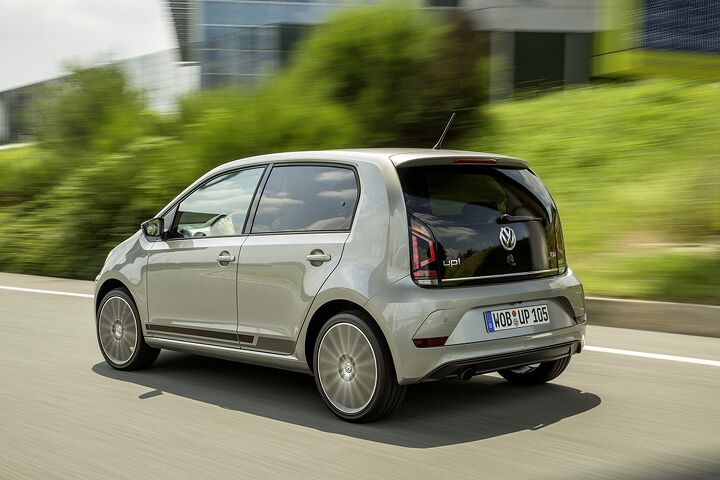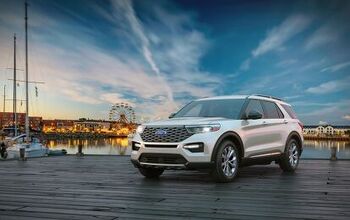Evidence Exhibit #127 In the Case of Market V. Small Cars: Volkswagen Considering Pulling the Up City Car From Europe
The global auto industry is not a place in which small car production is as straightforward as it was a decade or two ago.
Brought closer to home, Americans are buying roughly 30-percent fewer subcompact cars now than they were just three years ago. With next to no fuel economy advantages; limited payment upside; and less refinement, power, and space, why would a car buyer choose a subcompact over a compact sibling? Most buyers don’t. In the United States, compact car sales are five times stronger than subcompact sales. August’s top three compacts (Civic, Corolla, Cruze) outsold their subcompact brethren (Fit, Yaris, Sonic) by more than seven-to-one.
Many automakers don’t even bother selling their smallest cars in North America. Mazda’s latest 2 never saw U.S. import. FCA has left the compact market, having long since left the subcompact sector to rivals. Subaru doesn’t dive below the Impreza platform. And Volkswagen stops at the Golf, leaving the subcompact Polo for more small-car-friendly countries.
But how keen on small cars are those other countries? In some instances, not keen enough. Volkswagen boss Herbert Diess tells Autocar, “Selling small cars is not easy.” And he’s clearly not just talking about F-150-loving America. “It’s a very European problem,” says Diess. As a result, the Volkswagen Up city car, a Lupo successor, may pull out of Europe in favor of emerging markets only.
That means the same could happen for the Up’s Skoda sibling, the Skoda Citigo. “Of course, every car needs a sustainable business model and we want to improve on all our KPIs [key performance indicators] but we must also remember the Citigo is the entry point to our brand,” says Skoda’s CEO Bernhard Maier. “In emerging markets especially it plays a very strong role.” Based on demand in countries where small cars are bringing mobility to the masses, Maier doesn’t see production of the Up/Citigo ending.
But in Europe, specifically, there are real difficulties making A-segment cars sufficiently affordable to meet demand. Attempting to bring a small car like the Up into a low-emissions category requires high costs, but if those high costs are passed on to the consumer, virtually the whole appeal of the city car is lost. As B-segment cars such as Volkwagen’s own Polo become cleaner emitters, they compete too closely with A-segment cars in Europe’s regulatory environment.
Volkswagen can’t sell dirty Ups in Europe, but buyers won’t pay for an Up that costs nearly as much — or as much — as a Volkswagen Polo.
Presently, in the United Kingdom for instance, the Up is priced around 24-percent below the Polo. But that gap is tight. The Polo, for example, is a third less costly than the larger Golf. And the 24-percent reduction in cost from the Polo to Up represents the equivalent of just USD $3,700. Across Europe, the Up’s limited scope has produced ever decreasing sales. Up volume fell 4 percent in 2014, 16 percent in 2015, and 8 percent in 2016 61,246 before sliding 3 percent through 2017’s first seven months. The Polo is more than three times more popular than the Up in Europe; the Golf is nearly five times more popular.
If the Up could deliver a superior economic advantage, something Herbert Diess says is increasingly challenging, Volkswagen wouldn’t be considering the removal of the Up from its European lineup. Americans understand this already — otherwise, the 36-mpg $17,065 Fit would be outselling the 36-mpg $19,615 Civic seven-to-one rather than the other way around.
[Images: Volkswagen Group]
Timothy Cain is a contributing analyst at The Truth About Cars and Autofocus.ca and the founder and former editor of GoodCarBadCar.net. Follow on Twitter @timcaincars and Instagram.
More by Timothy Cain
Latest Car Reviews
Read moreLatest Product Reviews
Read moreRecent Comments
- Ajla A union fight? How retro 😎
- Analoggrotto Finally, some real entertainment: the Communists versus the MAGAs. FIGHT!
- Kjhkjlhkjhkljh kljhjkhjklhkjh *IF* i was buying a kia.. (better than a dodge from personal experience) .. it would be this Google > xoavzFHyIQYShould lead to a 2025 Ioniq 5 N pre-REVIEW by Jason Cammisa
- Analoggrotto Does anyone seriously listen to this?
- Thomas Same here....but keep in mind that EVs are already much more efficient than ICE vehicles. They need to catch up in all the other areas you mentioned.




































Comments
Join the conversation
C-segment is peak car right now. Something like a Civic combines the fuel economy of a Fit with the tech and most of the usable space of an Accord. It takes extenuating circumstances (challenging parking) or unique demands ("I like bigger cars") to really warrant moving off that peak (without defaulting to a crossover)
Technical error in this article. The Up! (sic) replaces the Fox which replaced the Lupo.